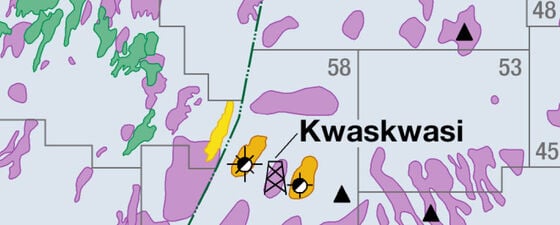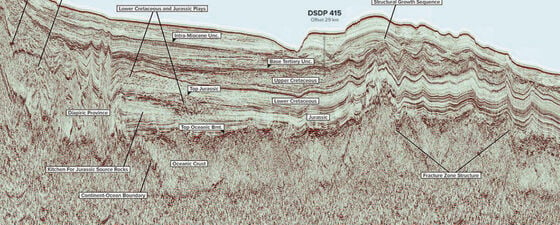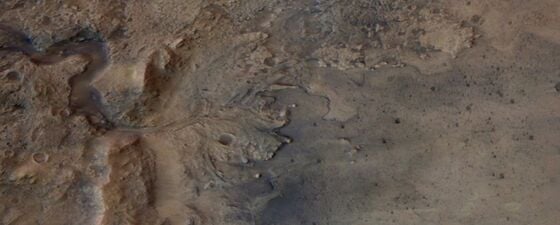The Neogene dynamics of the onshore Kwanza Basin have significant implications for oil and gas exploration of blocks offered in the ongoing onshore licensing round.
With the ongoing bid round for the onshore Kwanza Basin in mind (ANPG, 28 May 2020), this short article introduces the need to consider the exploration implications of the Neogene dynamics of Angola when reviewing the offered blocks. Instrumental to this consideration is the work of Jackson and Hudec (2009) who identified both the kilometre scale of Neogene (10-20 Ma years ago) events in western Angola and in the basin itself the presence of often clearly defined areas of uplift and salt withdrawal, with to the east the seawards slipped formation of the East Kwanza Foldbelt.
Figure 1: Oil seeps. (a) the exhumed oil column at Libongos (Tako Koning for scale); (b) downdip to the west, the free oil at Dande-4. Exploration for hydrocarbons in Angola commenced in 1915 with the drilling of Dande-1 and the first discovery of oil was the Dande-4 well in 1916; (c) villager in front of the Dande-4 casing, shows the oil freely flowing down the well head. Credit a Koning, 2012 Credit b and c Koning, 2015.
The onshore Kwanza has long been remarkable for hosting more oil-prone source horizons than perhaps any other basin of its size in Africa (Burwood, 1999). Some of the earliest oil found in Africa was encountered in oil seeps or asphalts, many of which along the basin margin are exhumed oil fields (Figure 1 and Koning, 2012). The basin also hosts quality reservoirs of a variety of ages and lithologies, plus numerous structural styles. Salt is widely present, providing closures and seal.
Despite these inherent advantages, after the drilling of over 100 exploration wells (Koch et al., 2013) since 1915, there have been no major oil or gas finds. Most wells, however, had decent oil shows, but they are old and are unlikely to be optimally positioned due to a lack of seismic control. The first of these wells was drilled in 1915 with no commercial success until 1955 (Koning, 2012). Subsequent exploration and development was impeded by Angola’s civil war which lasted from 1975 until 2002.
Migration is Key
One reason for the lack of major finds may be due to the fact that the Neogene events often post-date migration, so closures, and more especially the charges to older closures, have been liable to dispersal by tilt and therefore either leak to the surface or re-accumulate elsewhere.
From Figure 2, it is apparent that all nine produced fields in the onshore Kwanza Basin are either directly related to or closely associated either with minimal uplift (seven fields) or with maximal uplift (two fields). For the former, there will have been minimal, post charge migration and the initial charges will remain intact. In Quenguela Norte, the largest field, the source is Eocene black marls deposited in a precursor salt withdrawal structure and the charge is solely of Neogene age. For the maximal uplift area, the charge will be recent and possibly still ongoing.
Figure 2: Apparent control exercised by Neogene tectonism on the location of the onshore Kwanza Basin oil fields and asphalts.
The eastern margin of the basin, where the bulk of the asphalts are located (Sonangol, 2014) is typified by low angle, west dipping faults created by salt withdrawal away from regions of increasing uplift (Figure 3). The result is the recent and perhaps ongoing formation of the East Kwanza Foldbelt. Here it is suspected that oil migrated up-dip, aided by salt movement, to create the oil seeps and asphalts. The neutral line separating up-dip migration either to the east or the west follows the present deepest level of the top Cuvo surface (Hudec and Jackson, 2008, see Figure 2).
It is unclear where the oil seeps / asphalts, which are sourced from the pre-salt (Koning, 2015), originated from. The track of the Cabo Ledo Fault (Figure 2) inland towards the largest concentration of oil seeps / asphalts suggests that a significant portion of their oil may have been generated offshore. Related, cross-basin trending faults may have also supplied other oil seeps / asphalts, for example that at Libongos.
Figure 3: Combined dip and uplift profile for the central onshore Kwanza Basin. (for line of cross section see Figure 2).
Relevance to Onshore Round
In relation to the present round, KON 5, 6, 8 and 9 are attractively positioned both in relation to the regions of minimal and maximal uplift with their oil fields and the possible oil conduit track of the Cabo Ledo Fault. KON 17 and 18 lie towards the base of the tilt trend and could host live oil within the East Kwanza Foldbelt trapped by up-dip asphalts. This is the situation west of Libongos and close to the historic seeps where oil was found in the Dande-4 (Figure 1) which was drilled in 1916 to a depth of 857m and was tested at 6 barrels of oil per day.
References:
Abilio M. S., 1987. The geology and hydrocarbon potential of Angola. Oil and Gas Exploration in the SADACC Region, Arusha, Tanzania, 26-29 November 1986, Paper F, p. 129-150 (p. F-1 to F-20).
ANPG, 2020. Comunicado de Imprensa: anúncio promocional para as concessões petrolíiferas.
https://anpg.co.ao/comunicado-de-imprensa-anuncio-promocional-para-as-concessoes-petroliferas.
Burwood R. 1999. Angola: source rock control for Lower Congo coastal and Kwanza Basin Petroleum Systems. In: Cameron N.R., R.H. Bate and V.S. Clure (editors). The Oil and Gas Habitats of the South Atlantic, Special Publication of the Geological Society, 153, p. 181-194.
Hudec M.R. and M. P.A. Jackson, 2008. Structural segmentation, inversion, and salt tectonics on a passive margin: evolution of the Inner Kwanza Basin, Angola. Bulletin Geological Society of America, 114, 10, p. 1222-1244.
Jackson M.P. and Hudec M., 2009. AAPG International Conference and Exhibition, Cape Town, 26-29 October 2009. AAPG Search and Discovery Article #30091.
Koning T., 2015. Angola’s oil Industry — Celebrating a century of progress in exploration and production. Adapted from presentation at History of Petroleum Geology Forum, AAPG Convention & Exhibition, Denver, Colorado, May 31, 2015. AAPG Search and Discovery Article #70192.
Koning T., 2012. Milestones in Angola’s oil history. GEO ExPro, May 2012, p. 20-26. (link: https://www.geoexpro.com/articles/2012/10/milestones-in-angola-s-oil-history)
Sonangol, 2014. Re-awakening of the onshore Kwanza Basin: geology and prospectivity. http://www.internationalpavilion.com/Houston%20Talks%202014/Houston2014%20Angola.pdf.





